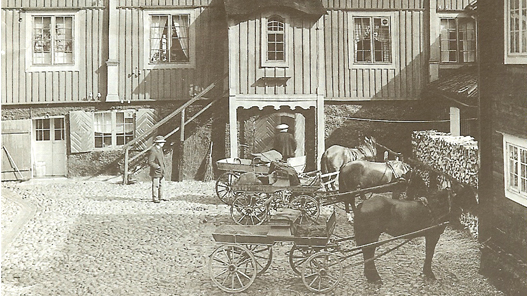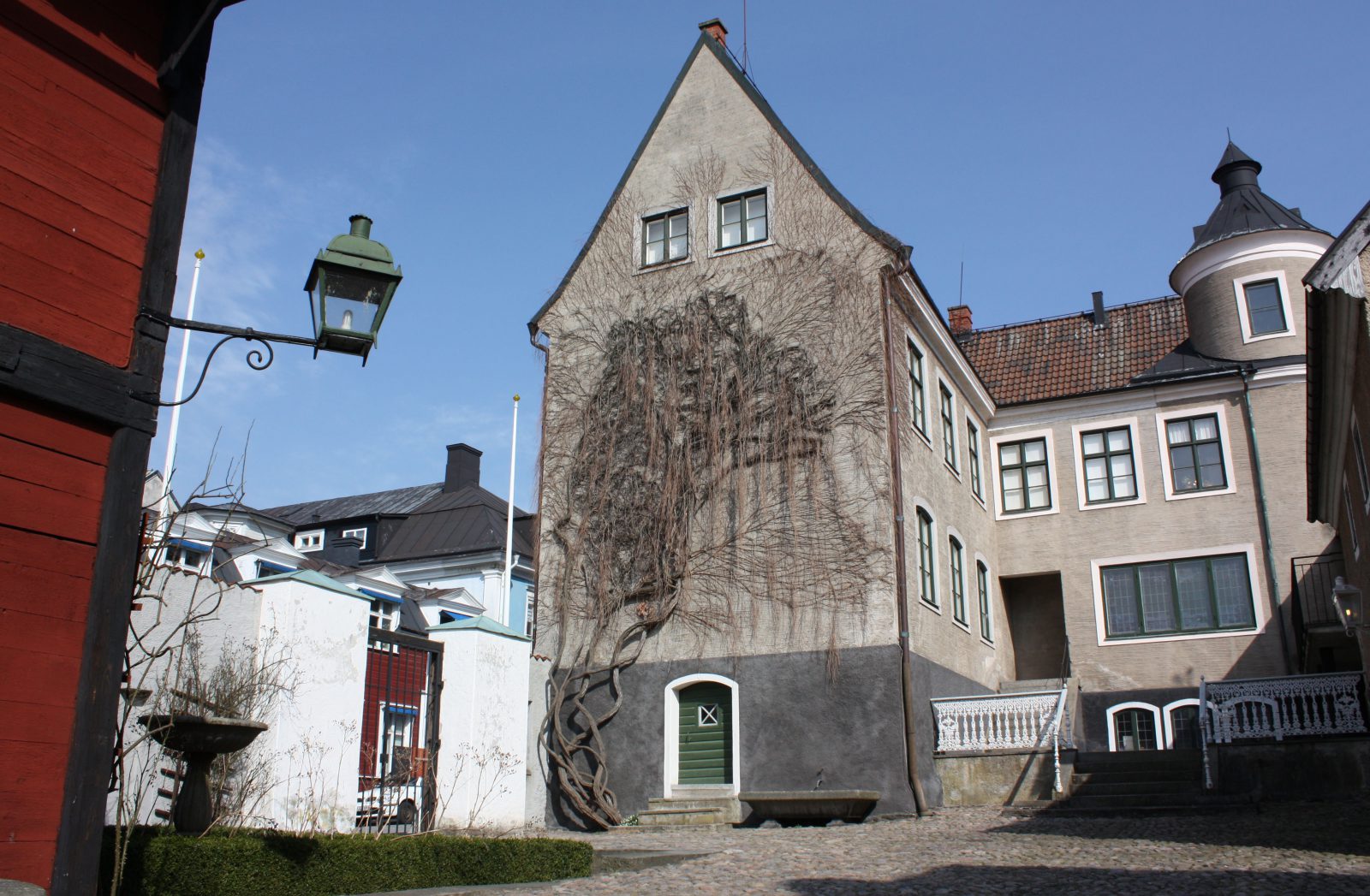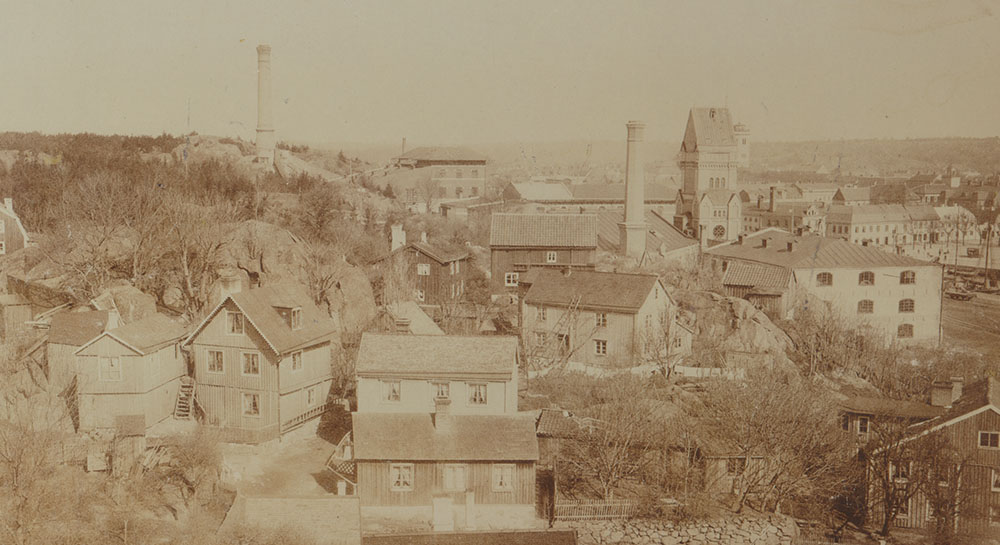
L. O. Smith and Karlshamn
The bustling port town of Karlshamn was where L. O. Smith spent his formative years. It was there that as a child he was taken under the wing of his mentor and protector, the merchant Carl Smith. He attended school there and discovered his talent for business early on. It was also in Karlshamn that Smith built his large distillery and produced the famous ‘Flaggpunsch’.
Karlshamn in Blekinge was originally a fishing village and a Danish shipping port, then called Bodekull. Following the Treaty of Roskilde in 1658, the southern Swedish provinces were incorporated into the Kingdom of Sweden. King Karl X Gustav immediately ordered towns to be constructed in the new provinces. Town charters were issued in 1664, and four years later the new trading town of Karlshamn received its royal privileges.
The idea from the beginning was to make Karlshamn a headquarters for the Swedish navy, but the conditions were considered to be better further east where the naval town of Karlskrona was founded. Nevertheless, Karlshamn continued to grow and several German and Dutch merchants moved in. The young town made its mark as an important commercial and maritime centre.
However, it was not until the Napoleonic Wars in the early 1800s that Karlshamn really took off. With France, at that time, trying to prevent shipping of English goods by means of a blockade, trade to Karlshamn soared. Sailing ships queued out in the roadstead to get into harbour and unload goods from all corners of the world. Karlshamn became known as a haunt of smugglers. The flourishing businesses brought prosperity and self-confidence to Karlshamn in the form of wealthy trading houses, and it was in that atmosphere that L. O. Smith grew up. Today you can follow in the footsteps of L. O. Smith in Karlshamn and see the places and buildings that played such an important role in his life.
Karlshamn’s cultural quarter
Karlshamn’s cultural quarter is today the name of some of the preserved neighbourhoods in the northern part of the city. It is here that the Karlshamn Museum Association maintains its collections in several of the old buildings, which were previously merchants’ estates and the associated stores. It is here that you can best experience the townscape, the streets and the neighbourhoods where L. O. Smith lived as a child and teenager. Adding to the overall effect of the environment is the unique Skottsbergska gården, which is managed by a private foundation.

Skottsbergska gården
Skottsbergska gården, one of Sweden’s best preserved historical merchant estates, can be found on Drottninggatan. Consul Smith lived on the same street, where he adopted the seven-year-old Lars Olsson as his foster son in 1843. Three years later, and with a sense of responsibility, Lars began earning his own money as a storehouse assistant for merchant Adolf Johan Skottsberg at Skottsbergska gården.
The estate was built in the 1760s by a famous ironworks proprietor, Olof Olsson senior, who among other things founded the Olofström ironworks. A. J. Skottsberg took over the estate in 1831 and owned it until 1856. When L. O. Smith arrived there as a 10-year-old, the business already had a long tradition to fall back on.
Today, Skottsbergska gården is an unusual monument. It was restored in the 1950s and since then has served as a museum. Visitors can see what a merchant’s estate looked like in the small Swedish towns of the 18th and 19th centuries.
There is an entrance to the shop itself on Drottninggatan. From there you go down a couple of steps to enter an environment where large parts of the interior from the 1700s remain intact. Here L. O. Smith served customers, dispensed flour and sugar, and ran to fetch hams and wine from the stores in the cellar vaults.
The living quarters face the street, with a representative façade on two floors. A double staircase of tarred Öland stone leads up to the entrance. The portal is high-quality rococo and richly decorated. Similar portals can be found on several of the estates in Karlshamn. Interior features include eleven tiled stoves preserved from the 18th century and decorated in colours such as blue, red, yellow and green.
The inner courtyard is accessed through large gates framed by a Gustavian portal. It is an entrance designed for horse-drawn vehicles and deliveries. Various estate buildings have been preserved, such as the brewhouse, stables, warehouses and woodsheds. It seems likely that the young Lars ran in and out of these timbered and red-painted buildings on many occasions to complete his errands.
Smithska huset
Smithska huset is the museum’s main building and is not named after the brännvin king himself, but his son Otto Smith. Otto lived here with his family from 1901 until his death in 1935. Originally the house was built in the 1760s after the Great Fire and so was also there when L. O. Smith moved to Karlshamn in the 1840s.
Otto Smith’s heirs sold the building to the municipality of Karlshamn at a favourable price on condition that it was used to establish a museum or some other cultural activity. The museum was opened on the upper floor in 1964 by Prince Bertil and since 1980 has made use of the entire building. Today it houses exhibitions depicting the history of Karlshamn, with an emphasis on trade and shipping.
The liquor company hall
A special exhibition at the museum tells the story of L. O. Smith and his enormous distillery in Karlshamn. There you can follow his life illustrated in a large number of paintings and among other things look at some of his letters written on a special letterhead. One of them is adorned by angels – who are producing brännvin.
Carl Gustafs kyrka
Construction of the church in Karlshamn commenced in the 1680s. The church was consecrated in 1702. It is named after King Karl X Gustav and was designed by Count Erik Dahlbergh, who is perhaps best known for his large illustrated work Suecia antiqua et hodierna, which depicted the new great power Sweden in all its glory.
The church is cruciform in shape and forms a striking silhouette in the cityscape just north of Stortorget. The finely carved pulpit in painted and gilded wood was put in place in 1837 and was donated by two of the town’s merchants. It was therefore quite new when the young Lars came to Karlshamn and as a small boy and teenager he would have listened to the priest’s words of admonishment and sermons from there.
The distillery
If you walk along the River Mieån near where it flows into the harbour you can see on the western quay the remnants of L. O. Smith’s large distillery from 1884. The castle-like buildings in dark red brick were designed in the neo-Gothic style by Professor Magnus Isaeus. In the 1890s, the distillery was converted into a sugar mill, a business that was still in operation in the 1950s. Today the factory area is owned by AAK, formerly Karlshamns AB, and is home to northern Europe’s largest vegetable oil factory. The old buildings fell into disrepair over many years and in 2016 a lower part of the property was demolished. The taller building still remains to be preserved and renovated.

